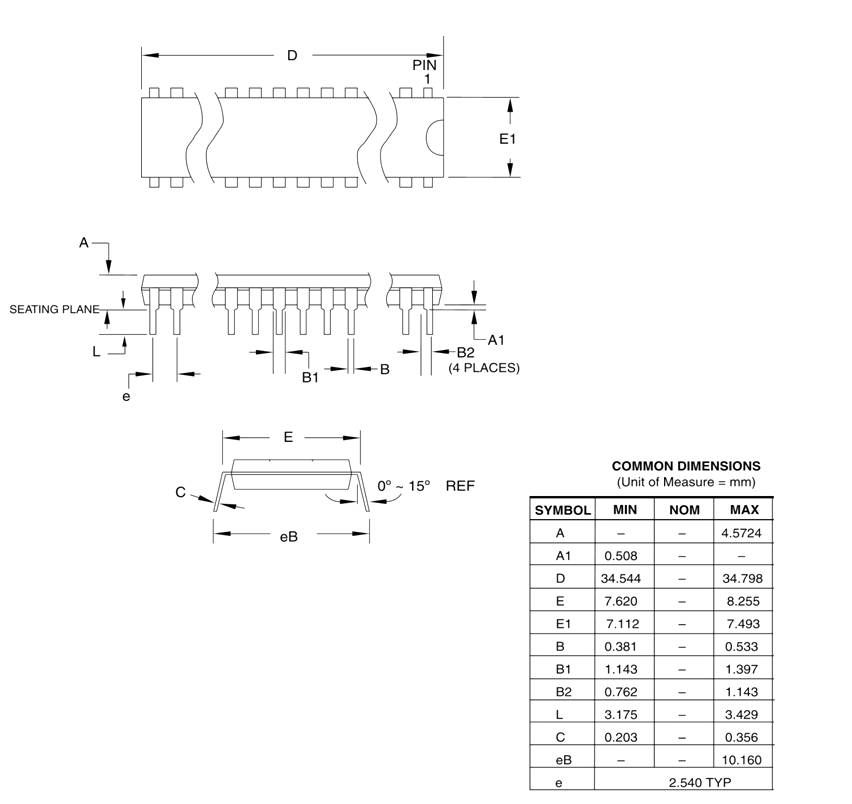Introduction
ATMega328P Microcontroller is a highly efficient and low-power controller developed by Microchip. It is an 8-bit microcontroller based on the AVR RISC architecture and is widely recognized for its extensive use in Arduino boards. In this article, we will explore the various features and capabilities of the ATMega328P-UP microcontroller.
ATMega328P-UP Microcontroller Pinout Configuration
The ATMega328P-UP microcontroller is equipped with 28 pins, each serving a specific purpose. Let’s delve into the functions of each pin:
| Pin No. | Pin name | Description | Secondary Function |
| 1 | PC6 (RESET) | Pin6 of PORTC | SS (SPI Slave Select Input). This pin is low when the controller acts as a slave.[Serial Peripheral Interface (SPI) for programming] OC1B (Timer/Counter1 Output Compare Match B Output) |
| 2 | PD0 (RXD) | Pin0 of PORTD | RXD (Data Input Pin for USART)USART Serial Communication Interface[Can be used for programming] |
| 3 | PD1 (TXD) | Pin1 of PORTD | TXD (Data Output Pin for USART)USART Serial Communication Interface[Can be used for programming] INT2( External Interrupt 2 Input) |
| 4 | PD2 (INT0) | Pin2 of PORTD | External Interrupt source 0 |
| 5 | PD3 (INT1/OC2B) | Pin3 of PORTD | External Interrupt source1 OC2B(PWM – Timer/Counter2 Output Compare Match B Output) |
| 6 | PD4 (XCK/T0) | Pin4 of PORTD | T0( Timer0 External Counter Input)XCK ( USART External Clock I/O) |
| 7 | VCC | Pin by default is used as RESET pin. PC6 can only be used as an I/O pin when RSTDISBL Fuse is programmed. | |
| 8 | GND | Connected to ground | |
| 9 | PB6 (XTAL1/TOSC1) | Pin6 of PORTB | XTAL1 (Chip Clock Oscillator pin 1 or External clock input)TOSC1 (Timer Oscillator pin 1) |
| 10 | PB7 (XTAL2/TOSC2) | Pin7 of PORTB | XTAL2 (Chip Clock Oscillator pin 2)TOSC2 (Timer Oscillator pin 2) |
| 11 | PD5(T1/OC0B) | Pin5 of PORTD | T1(Timer1 External Counter Input) OC0B(PWM – Timer/Counter0 Output Compare Match B Output) |
| 12 | PD6 (AIN0/OC0A) | Pin6 of PORTD | AIN0(Analog Comparator Positive I/P) OC0A(PWM – Timer/Counter0 Output Compare Match A Output) |
| 13 | PD7 (AIN1) | Pin7 of PORTD | AIN1(Analog Comparator Negative I/P) |
| 14 | PB0 (ICP1/CLKO) | Pin0 of PORTB | ICP1(Timer/Counter1 Input Capture Pin) CLKO (Divided System Clock. The divided system clock can be output on the PB0 pin) |
| 15 | PB1 (OC1A) | Pin1 of PORTB | OC1A (Timer/Counter1 Output Compare Match A Output) |
| 16 | PB2 (SS/OC1B) | Pin2 of PORTB | Connected to the positive voltage |
| 17 | PB3 (MOSI/OC2A) | Pin3 of PORTB | MISO (Master Input Slave Output). When the controller acts as a slave, the data is sent to the master by this controller through this pin. [Serial Peripheral Interface (SPI) for programming] |
| 18 | PB4 (MISO) | Pin4 of PORTB | SCK (SPI Bus Serial Clock). This is the clock shared between this controller and another system for accurate data transfer.[Serial Peripheral Interface (SPI) for programming] |
| 19 | PB5 (SCK) | Pin5 of PORTB | SS (SPI Slave Select Input). This pin is low when the controller acts as slave.[Serial Peripheral Interface (SPI) for programming] OC1B (Timer/Counter1 Output Compare Match B Output) |
| 20 | AVCC | Power for Internal ADC Converter | |
| 21 | AREF | Analog Reference Pin for ADC | |
| 22 | GND | GROUND | |
| 23 | PC0 (ADC0) | Pin0 of PORTC | ADC0 (ADC Input Channel 0) |
| 24 | PC1 (ADC1) | Pin1 of PORTC | ADC1 (ADC Input Channel 1) |
| 25 | PC2 (ADC2) | Pin2 of PORTC | ADC2 (ADC Input Channel 2) |
| 26 | PC3 (ADC3) | Pin3 of PORTC | ADC3 (ADC Input Channel 3) |
| 27 | PC4 (ADC4/SDA) | Pin4 of PORTC | ADC4 (ADC Input Channel 4)SDA (Two-wire Serial Bus Data Input/output Line) |
| 28 | PC5 (ADC5/SCL) | Pin5 of PORTC | ADC5 (ADC Input Channel 5)SCL (Two-wire Serial Bus Clock Line) |
Features
ATMega328P-UP – Simplified Features
| CPU | 8-bit AVR |
| Number of Pins | 28 |
| Operating Voltage (V) | +1.8 V TO +5.5V |
| Number of programmable I/O lines | 23 |
| Communication Interface | Master/Slave SPI Serial Interface(17,18,19 PINS) [Can be used for programming this controller]Programmable Serial USART(2,3 PINS) [Can be used for programming this controller]Two-wire Serial Interface(27,28 PINS)[Can be used to connect peripheral devices like Servos, sensors and memory devices] |
| JTAG Interface | Not available |
| ADC Module | 6channels, 10-bit resolution ADC |
| Timer Module | Two 8-bit counters with Separate Prescaler and compare mode, One 16-bit counter with Separate Prescaler, compare mode and capture mode. |
| Analog Comparators | 1(12,13 PINS) |
| DAC Module | Nil |
| PWM channels | 6 |
| External Oscillator | 0-4MHz @ 1.8V to 5.5V0-10MHz @ 2.7V to 5.5V0-20MHz @ 4.5V to 5.5V |
| Internal Oscillator | 8MHz Calibrated Internal Oscillator |
| Program Memory Type | Flash |
| Program Memory or Flash memory | 32Kbytes[10000 write/erase cycles] |
| CPU Speed | 1MIPS for 1MHz |
| RAM | 2Kbytes Internal SRAM |
| EEPROM | 1Kbytes EEPROM |
| Watchdog Timer | Programmable Watchdog Timer with Separate On-chipOscillator |
| Program Lock | Yes |
| Power Save Modes | Six Modes[Idle, ADC Noise Reduction, Power-save, Power-down, Standby and Extended Standby] |
| Operating Temperature | -40°C to +105°C(+105 being absolute maximum, -40 being absolute minimum) |
Note: Complete technical details can be found in the ATMega328P-UP Datasheet.
How to Use ATMega328P-UP Microcontroller
Using the ATMega328P-UP microcontroller is a straightforward process. To effectively utilize its capabilities, follow these steps:
- Identify Functions: Determine the specific functions you want the microcontroller to perform in your project.
- Write the Program: Utilize an Integrated Development Environment (IDE) such as Atmel Studio or Arduino IDE to write your program code. (Usually Atmel Studio 6.0 for Windows 7 http://atmel-studio.software.informer.com/6.0/, Atmel Studio 7 for Windows 10 https://www.microchip.com/avr-support/atmel-studio-7). These IDEs provide a user-friendly interface for programming AVR controllers.
- Compile and Generate HEX File: After writing the program, compile it within the IDE to identify and eliminate any errors. Once the code is error-free, generate a HEX file, which contains the machine code that will be written into the microcontroller’s flash memory.
- Select a Programmer: Choose an appropriate programming device, typically an SPI programmer designed for AVR controllers, to establish communication between your PC and the ATMega328P-UP microcontroller. Alternatively, you can use an Arduino Uno board to program the microcontroller.
- Burn the Program: Launch the programmer software and select the HEX file generated in the previous step. Proceed to burn the HEX file into the flash memory of the ATMega328P-UP microcontroller using the programmer. This process transfers your program code to the microcontroller.
- Hardware Connections: Disconnect the programmer and establish the necessary hardware connections between the microcontroller and peripherals required for your project. Ensure all connections are secure and accurate.
- System Initialization: With the program successfully burned into the microcontroller, you can now power up the system. The microcontroller will execute the code and initiate the specified functions.
How to Use ATMega328P-UP on the Arduino Platform
The ATMega328P-UP microcontroller is prominently used in Arduino Uno and Arduino Nano boards. If you wish to use the microcontroller independently, you can replace the entire Arduino board with the ATmega328 chip. Follow these steps to achieve this:
- Bootloader Installation: Install the Arduino bootloader onto the ATmega328 chip. This process involves burning the Arduino program into the chip, allowing it to function independently. You can accomplish this by placing the ATmega328 chip on an Arduino Uno board and using the appropriate tools and software to burn the program.
- Component Integration: Once the Arduino program is burnt into the ATmega328 chip, you can remove it from the Arduino Uno board. Connect additional components, such as a crystal oscillator and other peripherals required for your project, to the chip as needed.
- Pin Mapping: Ensure the necessary pin mapping between the Arduino Uno and the ATmega328P-UP chip is correctly established. Refer to the documentation or pinout diagrams to identify the corresponding connections.
By following these steps, you can leverage the capabilities of the ATMega328P-UP microcontroller on the Arduino platform or use it independently in your own projects, expanding its functionality based on your specific requirements.
Applications
The ATMega328P-UP microcontroller finds application in a wide range of areas, including:
- Arduino Boards: The ATMega328P-UP is widely used in Arduino Uno, Arduino Nano, and Arduino Micro boards, serving as the main controller for various projects and prototypes.
- Industrial Control Systems: With its versatile features and I/O capabilities, the microcontroller is employed in industrial control systems for automation, monitoring, and data processing applications.
- SMPS and Power Regulation Systems: The microcontroller plays a vital role in switch-mode power supply (SMPS) designs and power regulation systems, facilitating efficient power management and control.
- Digital Data Processing: Its processing power and I/O flexibility make the microcontroller suitable for digital data processing applications. It can handle tasks such as data acquisition, signal processing, and algorithm implementation.
- Analog Signal Measuring and Manipulation: With its built-in analog-to-digital converter (ADC) and analog comparator, the ATMega328P-UP is well-suited for measuring and manipulating analog signals. It finds applications in sensor interfacing, feedback control systems, and analog signal processing.
- Embedded Systems: The microcontroller is widely used in embedded systems, including coffee machines, vending machines, home automation systems, and consumer electronics. It’s low power consumption and compact size make it ideal for such applications.
- Motor Control Systems: Due to its PWM (Pulse Width Modulation) capabilities and multiple PWM channels, the ATMega328P-UP is commonly employed in motor control systems. It enables precise control over motor speed, direction, and torque.
- Display Units: The microcontroller can drive various types of displays, including LCDs (Liquid Crystal Displays), LED displays, and OLED displays. It is utilized in applications such as digital signage, information displays, and user interfaces.
- Peripheral Interface Systems: With its support for communication interfaces such as SPI (Serial Peripheral Interface) and USART (Universal Synchronous/Asynchronous Receiver/Transmitter), the microcontroller can interface with external devices such as sensors, memory modules, and communication modules.
Dimensions
The dimensions of the ATMega328P-UP microcontroller are as follows:
All measurements are in millimetres.

Conclusion
The ATMega328P-UP microcontroller, with its powerful features, low power consumption, and versatility, offers a wide range of possibilities for various electronic projects and applications. Its popularity in the Arduino community and its compatibility with the Arduino platform makes it a convenient choice for hobbyists and professionals alike. With the ability to program and customize its behaviour, the ATMega328P-UP allows you to create innovative and intelligent systems with ease. Whether you’re working on robotics, automation, data acquisition, or any other project, the ATMega328P-UP microcontroller provides a solid foundation to bring your ideas to life. Harness its capabilities, explore its features, and unlock the potential of this remarkable microcontroller to realize your electronic dreams.




